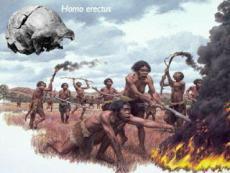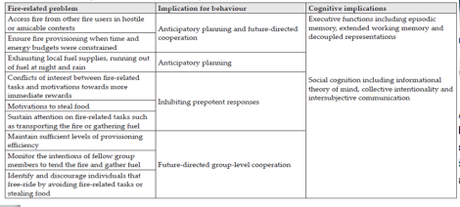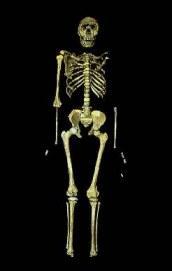The discovery of fire was a key moment in the human prehistory. With fire our ancestors would’ve been able to cook food, making digestion more efficient. The benefits of this are so great that we’ve now become dependent on cooking food and people who’ve attempted to live of raw food alone have suffered from chronic energy shortages and amenorrhea (Koebick et al., 1999). Fire also gives us a tool with which to fend of predators and extend daylight, giving us more time to socialise, work on tools etc. Nowadays humans are awake for almost twice as long as our closest ape relatives (Gowlett and Wrangham 2013); although personally I find the fact we only sleep 8 hours a day a bad thing.
Fire also marks a key moment in our intellectual development, since our ancestors would’ve had to be quite smart to use fire. But just how smart did they have to be? Terrence Twomey (2013) of the University of Melbourne has attempted to figure this out by looking at the simplest way they could’ve maintained fire and then examining the cognitive abilities required to do it. This provides a minimum “number” on just how intelligent our first fire using ancestors would’ve been, with the possibility remaining that they could actually be much more cognitively complex.

Our ancestors exploiting fire from a naturally occurring source, as per Twomey’s model
According to Twomey, the simplest way to exploit fire is to cultivate and maintain fire that occurred naturally, as a result of lightning or bushfires. As such they would’ve had to have figured out a way to protect it from the rain or wind. If this failed and the fire went out then our ancestors would’ve had to have taken some from a neighbouring group, either amicably or…not so amicably. This fire would’ve had to have been fuelled, forcing our ancestors to gather wood as well as the food they needed to survive. Our ancestors were also highly mobile during this period, frequently moving from place to place. Since they couldn’t relight the fire when they arrived they would’ve had to have figured out some way to transport it.
And what cognitive abilities would’ve been needed to live like this? Protecting and fuelling the fire would’ve required planning for the far future. Our ancestors often made tools at the location they were going to be used, suggesting they weren’t planning that far in advance (Potts, 1991). However, it’s no good gathering wood for a fire when it is needed, since the fire will be about to go out. Instead the fuel must be gathered in advance, showing our ancestors were able to plan for the more distant future.
However, gathering fuel requires time that could be spent acquiring food, socialising or doing other wholesome ape-man activities. Thus they must have also had the ability to inhibit the desire for immediate rewards, something which chimps aren’t particularly good at doing (Osvath and Osvath, 2008). This may have also required that they keep an eye out for free-loaders, who use the fire but don’t contribute to it. Acquiring fire from others would, if done amicably, require the ability of parties to co-operate. If done less amicably then the group doing the stealing would’ve still had to co-operate, albeit only with each other.

Twomey’s model of early fire use and the cognitive implications
In short, use of fire requires planning for the “far” future (which in reality would probably only be a few days), co-operation amongst the group, the ability to suppress the desire for immediate benefit and the ability to keep an eye on possible free-riders. In turn, that would likely require understanding of intentionality. In other words, our ancestors who used fire would’ve had to be pretty smart. Certainly well beyond modern apes.
So when were we this smart? Well the earliest evidence of fire use comes from Chesowanja, Africa and dates to 1.7 million years ago. There are series of patches of baked clay which have been viewed by many as hearths. However others have pointed out that they may be the result of tree-stumps burning for a long time during a bushfire; although the fact that the “hearths” occur close together yet contain less baked clay than would be expected if several tree stumps burned next to each other (Gowlett and Wrangham, 2013). More reliable evidence of fire doesn’t occur until 1 million years ago at Wonderwerk cave (Berna et al, 2012).

Narikotome boy, one of the most complete Homo erectus specimens discovered
Both of these dates place the first occurrence of fire within the time of Homo erectus. They evolved ~1.9 million years ago and were the first of our ancestors to have the modern human body plan of long legs, short arms, broad chest and tall torso. Despite this human-ness they still had relatively small brains (1000cc versus the modern 1350 cc) although they were still bigger than the earlier, more ape-like Australopiths.
So Homo erectus had the ability to plan ahead, work together, keep an eye out for cheaters and supress the desire for immediate gratification. This enabled them to use fire, with which they could cook, defend themselves from predators with and much more.
However, this conclusion is not final. Twomey only examines the cognitive capabilities behind what he views as the simplest method for maintaining fire. Other ways may appear more complex yet actually require less complex cognition. For example, his model is based around our ancestors exploiting and maintaining naturally occurring fire since creating fire is a more complex behaviour. But if they could create fire then they wouldn’t have to worry about protecting it or ensuring it was always lit, so on balance it may be that this method is actually the “minimal” version.
This is a point Twomey concedes and he notes that more work is needed to examine these possibilities. Until that is performed I’ll hold off making any definitive statements about the intellect of Homo erectus. Nonetheless, this is an interesting approach that suggests our ancestors were quite smart indeed.
References
Berna F, Goldberg P, Horwitz LK, Brink J, Holt S, Bamford M, & Chazan M (2012). Microstratigraphic evidence of in situ fire in the Acheulean strata of Wonderwerk Cave, Northern Cape province, South Africa. Proceedings of the National Academy of Sciences of the United States of America
Gowlett (2009). The Longest Transition or Multiple Revolutions?
Curves and Steps in the Record of Human Origins Sourcebook of Paleolithic Transitions, 65-78
Gowlett, J. A., & Wrangham, R. W. (2013). Earliest fire in Africa: towards the convergence of archaeological evidence and the cooking hypothesis. Azania: Archaeological Research in Africa, 48(1), 5-30.
Osvath, M. & H. Osvath, 2008. Chimpanzee (Pan troglodytes) and orangutan (Pongo abelii) forethought: self-control and pre-experience in the face of future tool use. Animal Cognition 11, 661–74.
Potts, R. (1991). Why the Oldowan? Plio-Pleistocene toolmaking and the transport of resources. Journal of Anthropological Research, 153-176.
Twomey, T. (2013). The Cognitive Implications of Controlled Fire Use by Early Humans. Cambridge Archaeological Journal, 23(01), 113-128.

